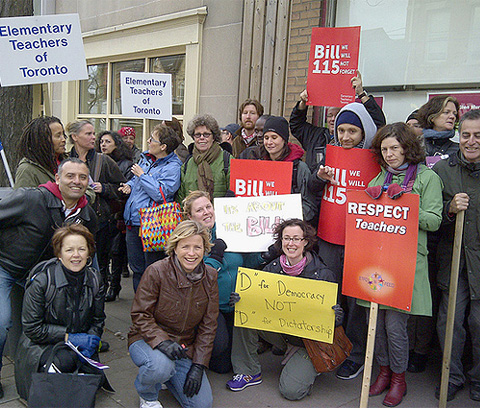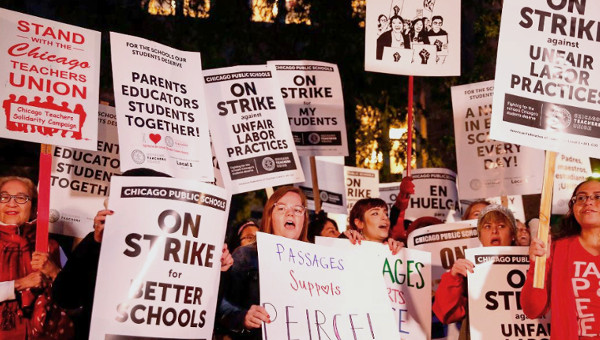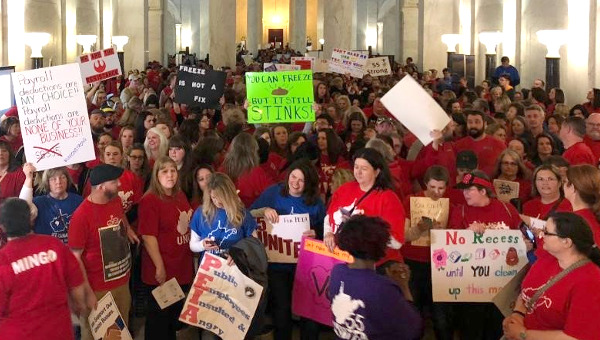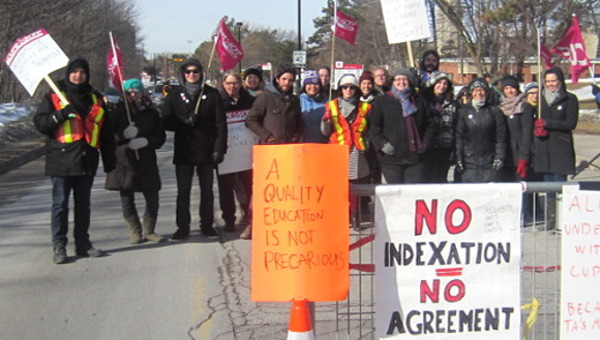On January 3, Ontario Education Minister Laurel Broten announced that she will be imposing concessionary contracts on the province’s teachers. This is a drastic attack on collective bargaining rights that the teachers have said they will fight. It follows on the heals of the Liberal minority government’s Bill 115, “An Act to Implement Restraint Measures in the Education System,” passed last September with the support of the Conservatives.

The Liberal attacks have clearly ruptured their previous relationship with teachers’ unions. Teachers and their allies need to punish the Liberals by supporting the NDP. However, Andrea Horwath and the NDP have been fairly low-profile in the fight against Bill 115. Rather than attempting to contribute to the fight or publicly endorse the teachers’ actions, the NDP seems to merely want to pick up the support of disgruntled teachers and parents by default.
To their credit, the NDP’s Provincial Council did pass a resolution against Bill 115. However, on December 11, the day after the first of the elementary teachers’ rotating strikes, Horwath struck an odd note by telling the media she would be willing to work with the new Liberal leader.
Horwath has been so committed to her Jack Layton style mantra of “getting results for people” that she seems to have missed the fact that the Liberals are relatively unpopular and are engaged in attacking collective bargaining rights. At least she could have clearly staked out a clear position that made any future deals dependent upon the repeal of Bill 115 and the renewal of negotiations with the education workers’ union.
The Ontario NDP is very much in line with the trajectory of the NDP across the country staking out a moderate position and essentially trying to beat the Liberals at their own game. They are not a force that will defend the labour movement against Liberal and Conservative attacks. However, a mobilization by the labour movement against Bill 115 poses the possibility that such a force can be built outside of Québec.
This article analyses the emergent teachers’ struggle and its implications for the NDP and larger struggles in Ontario and across Canada.
Context: Where are the Movements Against Austerity?
Despite the economic crisis and the turn to public sector austerity there has been disappointingly little resistance or movement for alternatives in Canada. The economic crisis which began in 2008 shook the capitalist system, but has not dramatically affected the political climate in Canada and the USA. It certainly hasn’t created a shift to the left. Rather remarkably, the crisis has not undermined neoliberal free-market capitalism.
Instead, the crisis has been used to further the attack on collective bargaining, wage levels, public services and social programs. The impact is felt across the working-class, but disproportionately hits women as low wage workers, as workers in the public sector and who are still responsible for the majority of household labour.
Meanwhile, the Harper government panders to a racist backlash through anti-immigrant rhetoric and cuts to healthcare for refugees, while increasing the exploitation of temporary foreign workers in Canada.
A major exception, of course, was the Québec student strike, which was an amazing and ultimately successful fight. While the struggle in Québec inspired and informed activists elsewhere, it hasn’t had an immediate impact on the political climate or social struggles in the rest of the country, despite impressive solidarity actions.
Ontario: The Fight Against Bill 115
Outside of Québec, the labour and social movements have been largely disorganized and defensive and unable to wage a significant fight against austerity. Private sector unions, including the Canadian Auto Workers, have failed to provide a serious or militant defence against employer attacks and plant closures. Public sector unions are on the defensive across the country.
In Ontario, like Québec, the widest struggle has involved the education sector, but in this case, the elementary and secondary school systems and the collective bargaining rights of education workers. Bill 115 effectively removed the right of teachers and support, custodial and clerical staff to collectively bargain. Bypassing local school boards, absolute authority was vested in the Minister of Education to unilaterally accept, reject or ultimately impose collective agreements upon Ontario education workers.
In July, the leadership of the Ontario English Catholic Teachers Association (OECTA) had accepted a concession-based Memorandum of Understanding (MOU) with the provincial government. This MOU became the provincial government’s framework for all subsequent contract negotiations. If no ‘voluntary’ agreements could be reached within the parameters of Bill 115 by December 31, the government warned that collective agreements would be imposed upon the recalcitrant unions in the new year.
In the face of this legislative assault, the Elementary Teachers’ Federation of Ontario (ETFO), the Ontario Secondary School Teachers’ Federation (OSSTF) and the Canadian Union of Public Employees (CUPE) – representing education support workers – began mobilizing against the Liberal government. However, building a successful fightback has faced a number of challenges.
First of all, the unions are relying too heavily on and placing too much hope in a legal challenge of the constitutionality of the government’s legislation. This is a misreading of the progressive potential of the courts and the Charter of Rights. More practically, this avenue is notoriously slow and expensive. Ultimately, victories in the courts may also be circumvented by governments that re-enact similar legislation. Still, the legal challenge is a necessary tactic. While it can tend to be demobilizing, in this case the widely held conviction among teachers that the bill is contrary to the Charter seems to have buoyed their resolve and sense of injustice.
The teachers have struggled to present their fight as one about the quality of public services. Like other unionized employees, teachers have been faced with some degree of a public backlash from workers who lack their wage levels, job security, benefits and pensions. Pushed by rightwing politicians and the mainstream media, this discourse is to be expected. And, of course, like other public sector workers, the teachers are faced with the challenge of taking forms of job action that inconvenience and risk alienating the public.
Members of both OSSTF and ETFO have been engaged, rather unevenly across the province, in work-to-rule campaigns that have involved the withdrawal of administrative labour and extracurricular activities such as sports and clubs. While this was a necessary step to place pressure on the government and is understood by many parents and students, it does have risks.

[Photo credit: Scott Neigh]
Getting an alternate message across that can resonate with the public becomes fundamentally important. The teachers have primarily emphasized the attack on their collective bargaining rights and the extent to which this infringes upon Charter rights. The ETFO launched an advertizing campaign complete with billboards declaring that “If You Work In Ontario, This Is Your Fight.”
The emphasis on workers’ rights rather than protecting public services is an interesting choice. It also seems notable that there has been little effort to emphasize that the majority of teachers are female, even if much of the union leadership is male.
Perhaps surprisingly, considering the vocal examples of teacher-bashing and the seeming weakness of their messaging, the teachers have done reasonably well in the court of public opinion. A poll released in mid-December suggested that more people supported the teachers than the government in this fight.
In the fall, a number of student walkouts occurred at schools around the province. An impressive student-organized rally against Bill 115 was held at Queen’s Park on December 13. Student anger about the withdrawal of extracurricular activities has primarily, but not exclusively, been directed at the government. This is happening despite the weakness of the unions’ communication strategy with parents and the public.
Labour Solidarity?
The rest of the labour movement, in the public and private sectors, has been slow to offer real support and solidarity despite the fact that the broader public sector in Ontario is also faced with a proposed piece of legislation that would destroy collective bargaining rights.
In October, the Liberals tabled the “Protecting Public Services Act” directed at the wider provincial public sector, including universities, healthcare and the Ontario public service. Patterned after Bill 115, this piece of legislation, if passed, would also allow the provincial cabinet to unilaterally re-write and impose collective agreements on public sector workers. Unfortunately, there just aren’t enough organized left caucuses within the teaching unions or the rest of the labour movement to push these struggles forward.
Further challenges include the divisions between the various unions and the history of close relations between the teachers’ unions and the Ontario Liberal Party. The OECTA deal with the government set a terrible precedent for their fellow education workers. The rest of the unions criticized the Memorandum of Understanding and Bill 115, but they have failed to build a real common front against the government.
“The Working Families Coalition” and Liberal Betrayal
It has widely been noted that the teacher’s unions are being betrayed by their friends in the Liberal government that they helped elect. This is certainly accurate. Based on the online data available from Elections Ontario, the Liberals have received more donations from the entire union movement than the NDP over the period of 2004-2011. And looking specifically at the teachers’ unions, OECTA and OSSTF have been considerably more generous to the Liberals than the NDP, while ETFO has given comparable amounts to both parties. CUPE, on the other hand, has been loyal to the NDP.
Due to election finance regulations in Ontario, the amounts that unions (and corporations and individuals) can donate to political parties is limited, however the amount that unions (and corporations and individuals) can spend on so-called third party advertizing is not capped. So third-party advertizing is where the big spending occurs.
The Ontario teachers’ unions have been actively supporting strategic voting and backing primarily Liberal candidates to defeat the Conservatives since 1999. In 2003, OSSTF, OECTA, the building trades and the CAW formed the Working Families Coalition to engage in third party advertizing to essentially support the Liberals over the Conservatives. Over the last three elections, the Working Families Coalition has been a major third party advertiser hammering away at the Conservatives and implicitly endorsing the Liberals.
During the 2011 election, OECTA gave the Working Families Coalition $250,000 while OSSTF and ETFO both contributed $100,000. Contributions from the teachers and other unions allowed the Working Families Coalition to spend over $1-million essentially endorsing the Liberal government. Beyond that, on their own, ETFO spent $2.7-million and OECTA spent $1.9-million on advertizing during the 2011 election to basically defend the Liberal record on education and attack the Conservatives.
In other words, the teacher’s unions have developed a close relationship with the Liberal party and some activists have feared that the unions are merely waiting for an opportunity to patch up their differences rather than fight against Bill 115.
OSSTF: The Membership Steps Up to Fight
The OSSTF leadership has taken a stop and start process to mobilizing its members and taking action against the government. This has repeatedly left the impression that the union leadership would rather work out a compromise deal rather than mobilize its members and confront the Liberal government.
Before the passage of Bill 115, the OSSTF postponed strike votes. Once the legislation was passed, OSSTF locals held strike votes in September and received a 92 per cent strike mandate across the province. By the end of September some OSSTF members were beginning to withdraw extracurricular and some other activities, in essence moving toward a work-to-rule campaign, however this was not coordinated across the province by the union leadership.
When Dalton McGuinty unexpectedly announced his resignation as Liberal leader and premier on October 15 and prorogued the legislature, the OSSTF leadership released a rather bizarre statement thanking McGuinty for being “the education premier for many years” and welcoming “the opportunity to work with a new leader in the near future and a return to the collaborative environment that existed in the past.”
In early November, OSSTF announced that some locals would begin taking what the union described as “strike actions” on November 6. They then delayed these actions by five days to hold negotiations with the government under a media blackout. These so-called “strikes” were actually work-to-rule campaigns. Within a week, some OSSTF locals were reaching tentative agreements with local school boards. Rather than escalating the struggle, OSSTF seemed to be compromising with the government and working within the tight constraints of Bill 115.
A crucial development for OSSTF and the wider struggle against Bill 115 was the rejection of tentative agreements by OSSTF members in York Region and Niagara on November 26. These were followed by another no vote by OSSTF members in Hamilton-Wentworth. If these agreements had been accepted, the momentum toward a collapse of the struggle would likely have been irresistible. At least, ETFO would have become increasingly isolated. The work of local activists within OSSTF to mobilize against these tentative agreements was fundamentally important in helping sustain the struggle.
The rejection of these agreements by the membership and the rejection of other tentative deals by the Ministry of Education led OSSTF to postpone other ratification votes and suspend further negotiations. Instead, OSSTF was pushed to move to an across the province work-to-rule campaign beginning on December 10.
OSSTF members withdrew from extracurricular and other voluntary activities and began showing up only 15 minutes before the start of school and leaving after their final class as required in the Education Act. Furthermore, in December, OSSTF held a membership vote and received a mandate to hold “a one day political protest” against Bill 115 sometime in the future.
ETFO: From Taking a Pause to Rotating One Day Strikes
Early in September, the ETFO leadership urged its members to “take a pause” on voluntary activities including extracurriculars, and introduced “McGuinty Mondays” – asking its members to boycott meetings and limit the length of their work day on Mondays. Elementary teachers were also advised to limit report card comments to the minimum required by Education Ministry policy. In late November, ETFO locals began launching full work-to-rule campaigns. In early December, ETFO held an online membership vote, giving their leadership a mandate to call “a full-day political protest” if the Minister of Education imposed a contract via Bill 115.
ETFO members began a series of rotating one-day strikes on December 10. ETFO announced that they would not strike anywhere without giving 72 hours notice to parents and the public. The largest strike occurred on December 18 when close to half of Ontario’s elementary teachers, including those at the Toronto District School Board, went on strike. These were impressive actions with large and spirited picket lines that received many signs of public support. Still, it remained unclear whether they were the beginning or the end of the teachers’ mobilization.
On December 21, ETFO announced that they wouldn’t take any further strike action if the Education Minister was willing to back away from imposing contracts through Bill 115. Furthermore the proposed truce would last until a new Liberal leader was selected. It is hard to know if this revealed any false illusions about Liberal leadership candidates or was merely a wise public relations gesture. In any case, Laurel Broten’s subsequent actions have made such a truce impossible.
CUPE: A Last-Minute Deal with the Government
CUPE, which represents 55,000 support workers in the education system, did very little to mobilize its membership. The CUPE leadership complained on the one hand that Bill 115 affects more than just teachers, but CUPE did very little to make support workers visible to the public. CUPE school board workers voted 88 per cent in favour of strike action, but not a single CUPE local began a work-to-rule action or went on strike for even a day. Taking some sort of action beyond local rallies and protests would have made the point that not only teachers were affected by Bill 115.
On December 20, CUPE-Ontario president Fred Hahn announced that if the government attempted to impose collective agreements on CUPE workers through Bill 115, then CUPE would immediately call on school board workers to stage a one-day job action. Ultimately, CUPE came to a last-minute deal with the provincial government on December 30. The details of that deal have not been made public but the CUPE education local membership will be voting on it by January 14.
What comes Next?
Toward a Province-Wide Day of Action
Education Minister Laurel Broten has thrown down the gauntlet and announced that she will be imposing contracts on ETFO and OSSTF members. She also had the gall to suggest that after having imposed contracts, she would then repeal Bill 115 – as if that were some sort of concession to the teachers.
The Ontario Liberal Party will choose its next leader and the next premier of Ontario at its convention in Toronto on January 26. The Ontario Federation of Labour is planning a major demonstration on that date and undoubtedly many teachers will be there.
Both the OSSTF and ETFO leadership have mandates from their membership to hold a one-day political protest. There are fears that they may want to hold this on a professional activity day or even on a weekend rather than a school day. This would be a major retreat and disappointment.
It’s crucial that teachers maintain the momentum of their struggle. As teachers return to the classroom on January 7, it can’t be business as usual. Teachers will need to continue to “take a pause” to indicate that the struggle continues. And even more importantly, a day of protest needs to happen soon. In 1997 Ontario teachers walked off the job to protest the Mike Harris government’s legislative assault. The illegal strike lasted for two weeks. It has been done before and it can be done again.
If there isn’t a major fight against Bill 115 to defend collective bargaining and public education in Ontario, the rest of the public sector workforce will be next in line. What would it take to escalate the struggle against the austerity regime in Ontario? Wouldn’t a province-wide illegal strike by education workers, bolstered by community and labour solidarity actions, have an impact on the austerity agenda and the political debate – including, but not limited to, the next provincial election campaign?
As in Québec last year, defeating Ontario’s Liberal government will be a priority in the next election. Not only have the Liberals attacked collective bargaining rights, but they are a tired government plagued by a variety of scandals. Their veneer of progressivism is shattered.
The next provincial election could very well see a degree of polarization between the Conservatives and the NDP. Tim Hudak’s Conservatives know what they stand for: a return to the “Common Sense Revolution” of Mike Harris, including a frontal attack on the labour movement and social services. Andrea Horwath’s NDP needs to offer more than platitudes about “getting results for people” and targeted tax credits for business.
Significant labour movement support should shift from the Liberals to the NDP, but it shouldn’t be a blank cheque. The labour movement should seek some concrete policy commitments from the NDP. Even more fundamentally, the labour movement mustn’t limit its strategy to an electoral shift from Liberal to NDP.
The labour movement will only be able to defeat the austerity agenda and the assault on trade union rights by renewing its tactics, organization and social vision. This will only happen, if at all, through new forms of local activism and through the development of networks of activists across and beyond the labour movement.
Postscript: The Labour Relations Board
and the Union Retreat
For a brief moment in early January, it appeared that the teachers’ struggle actually was going to escalate to the next level – province-wide walkouts. The elementary teachers announced they would walk out on Friday, January 11 and the secondary teachers would do likewise on Wednesday, January 16.
However, a last minute decision by the Ontario Labour Relations Board declared the planned ETFO actions illegal and the union leadership backed down. OSSTF quickly called off their action as well. Bill 115 expressly prevented the board from deciding on the constitutionality of Bill 115 itself, so the legal deck was clearly stacked against the teachers by the McGuinty government.
The labour board decision wasn’t a surprise. Maybe, it came quicker than expected. But the union leadership had to see it coming. In fact, the ETFO leadership had given the impression that their members would strike on Friday whether it was legal or not. A strike during a collective agreement, under the Canadian collective bargaining regime is essentially illegal by definition. And Laurel Broten had imposed agreements on the teachers. That’s the crux of the matter right there. Surely, this was a perfect example of an unjust and absurd law that could have been flaunted for the sake of a higher principle.
The union retreat left many teachers angry and disappointed. A major opportunity was missed. The resulting confusion in the education sector on the date of the cancelled walk-out, with low levels of student attendance, was small consolation. The social struggle against Bill 115 is waning. For now, many teachers will continue to withdraw voluntary activities. After-school protests are planned and a major protest will confront the Liberals as they choose their new leader on January 26 in Toronto.
It will be up to radicalized and mobilized education workers to determine the best way to continue this struggle, engage the public, build grassroots networks (such as the Rank-and-File Education Workers of Toronto), transform their unions, and build bridges with other workers and community groups. •
An earlier version of this article first appeared on the New Socialist Webzine site.






